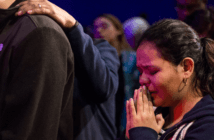At an event I was approached by a well-dressed older woman who said, “We are willing to do whatever it takes to get the next generation of leaders involved. We will invest our time to train them, equip them, and guide them as they learn how to run this congregation. It’s their turn to step up, just like we did when we were their age.” It seemed like a noble gesture on her part, her willingness to invest in the next generation. But there was an unstated assumption beneath her offer. They will have to learn how to run the organization our way, before we yield leadership to them. She didn’t consider that the next generation of leaders might reshape the organization in significant ways, before they accept the leadership reins. What will it take to turn the leadership of the church over to the next generation? How will the church negotiate the transition?
The church has spent a lot of time and energy talking about the preferred worship styles of Gen X and Millennials. It is time we attend to their preferences in volunteerism and leadership as well.
The Seismic Shift in Volunteerism
The good news is that volunteerism is actually on the rise in our culture. However, the places we find volunteers are shifting. The rate of volunteering inside of the church has dropped dramatically, while the rate of volunteering among people who don’t attend church or civic organizations has nearly tripled in the last twenty years. Volunteerism today requires greater flexibility, better use of technology, and more episodic opportunities for volunteering. Volunteerism has shifted away from an emphasis on skilled workers (who show up and do the tasks they have been assigned), to knowledge workers (who expect to be empowered with decision making). People are no longer willing to serve on labor intensive, slow moving committees. They are attracted to micro-projects with fast turnaround times and more focused commitments.
Streamlined Structures
For a long time we have approached the leadership development task from the perspective of the organization. What slots do we have open, and how many bodies do we need to equip existing structures? Next generation leadership requires a shift in our orientation, away from the organization as the center of the conversation, and towards the needs and availability of volunteers. The next generation leader wants to bring personal gifts and interests to bear on the needs of the organization. They are passionate about specific causes. They are attracted to smaller projects with bigger impact. With this in mind, we need to reduce the size and complexity of our governance structures. Committees need to be reduced, and in some cases eliminated. We will have to replace ongoing process work with discrete tasks that fit together into a cohesive whole. We need to streamline decision making to facilitate a faster pace of work.
Meeting through Technology
Congregations historically employ committee structures to do our work and strengthen our sense of community through the work that we do together. Gen X (born 1965-1984) and Millennials (born 1985-2004) would rather find their community connections in other kinds of groups, and make decisions together using more nimble structures. Social media is a natural language for them, and they know how to make strong personal connections over the internet. They are masters of technologies that allow for sharing and shaping information together online. They are comfortable making decisions virtually. Additionally, their available time to do church work is often when others are not available. They need to do their work when personal schedules allow, and they prefer to join a virtual conversation according to their own timeframe. We need to learn how to join them in their world, not just expect them to accommodate ours.
Let Them Teach You
Historically, we have thought about leadership development as a process of teaching and equipping those who are coming up in the ranks behind us. They watch us do it. They do it with us. We watch them do it. Finally, we let them lead. The next generation of leaders is going to pick up the reins differently. They are confident, self-expressive, connected, and open to change. They expect their efforts to result in change, not the maintenance of the status quo. Gen X and Millennials grew up in the digital age. They process information very differently than the Silent (born 1925-1945) and Boomer (born 1946-1965) generations. Boomers grew up with analog data. We think and process information in a linear fashion. Gen X and Millennials are not bound by linear thinking. They leap ahead in the process to access the piece of information or resource that best serves the moment. We can learn things about the efficiency of our congregations from the different ways that their brains work. We should let them teach us.
Preserve the DNA, Adapt Anything Else
I do not mean to suggest that we simply throw up our hands and let the next generations do whatever they like. I do believe that we should identify our core operating principles and values to protect, and then let everything else evolve. We often don’t know how to distinguish between the critical DNA that marks our distinctiveness, and everything else that we do in the name of tradition. The next generations display a high level of respect for their elders. They are very tolerant of diversity and will embrace serving in leadership alongside their elders. However, their respect for people will not override their impatience with outdated technologies and bureaucratic structures. The church has spent a lot of time and energy talking about the preferred worship styles of Gen X and Millennials. It is time we attend to their preferences in volunteerism and leadership as well. The next generations will surprise us with their capacity for organizational leadership, on their terms.
Related Resources:
- Making Space for Faithful Following by Denise Janssen
- The Emergence of “Dones” by Lovett H. Weems, Jr.
- Lessons on Engaging Young Adults Effectively by Asa J. Lee
- Reach More Volunteers by Jim Cowart and Jennifer Cowart







